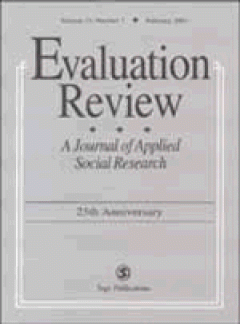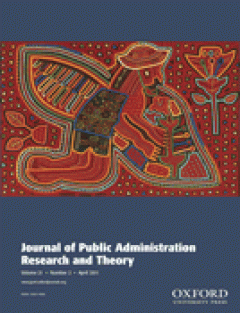Filter by

Evaluating Health Outcomes of Criminal Justice Populations Using Record Linka…
Individuals in contact with the criminal justice system are a key population of concern to public health. Record linkage studies can be useful for studying health outcomes for this group, but the use of aliases complicates the process of linking records across databases. This study was undertaken to determine the impact of aliases on sensitivity and specificity of record linkage and how this af…
- Edition
- Vol. 35 no. 2, April 2011.pp. 118-128
- ISBN/ISSN
- 0193841x
- Collation
- -
- Series Title
- Evaluation Review
- Call Number
- -

Mandatory, Preferred, or Discretionary : How the Classification of Domestic V…
- Edition
- Vol. 35 no. 2, April 2011.pp. 129-152
- ISBN/ISSN
- 0193841x
- Collation
- -
- Series Title
- Evaluation Review
- Call Number
- -
- Edition
- Vol. 35 no. 2, April 2011.pp. 129-152
- ISBN/ISSN
- 0193841x
- Collation
- -
- Series Title
- Evaluation Review
- Call Number
- -

Evaluation of Free to Grow : Head Start Partnerships to Promote Substance-Fre…
Free to Grow: Head Start Partnerships to Promote Substance-free Communities (FTG) was a national initiative in which local Head Start (HS) agencies, in partnership with other community organizations, implemented a mix of evidence-based family-strengthening and community-strengthening strategies. The evaluation of FTG used a quasi-experimental design to compare 14 communities that participated i…
- Edition
- Vol. 35 no. 2, April 2011.pp. 153-188
- ISBN/ISSN
- 0193841x
- Collation
- -
- Series Title
- Evaluation Review
- Call Number
- -

The Distinction between Public, Nonprofit, and For-Profit : Revisiting the �…
In studying the characteristics that determine the public, nonprofit, and/or for-profit nature of organizations, public administration scholarship has elaborated upon the �dimensional� approach (e.g., Bozeman, Barry. 2007. Public values and public interest: Counterbalancing economic individualism. Washington, DC: Georgetown Univ. Press), to the point where it is now furnishing a rich body of th…
- Edition
- Volume 21, Number 1, January 2011.pp. 3-26
- ISBN/ISSN
- 10531858
- Collation
- -
- Series Title
- Journal of Public Administration Research and Theory
- Call Number
- -

Public Service Ethos : Developing a Generic Measure
This article conceptualizes public service ethos as a multidimensional construct and develops a framework that explains first, why individuals are motivated by this ethos (Public Service Belief); second, how they deliver public services in accordance with this ethos (Public Service Practice); and third, what ends they perceive it to endorse (Public Interest). Despite considerable interest in pu…
- Edition
- Vol. 21, Number. 1, January 2011.pp. 27-51
- ISBN/ISSN
- 10531858
- Collation
- -
- Series Title
- Journal of Public Administration Research and Theory
- Call Number
- -

Managerial Trustworthiness and Organizational Outcomes
Using data from the Federal Human Capital Survey, we demonstrate that the managerial traits of competence, integrity, and benevolence share an important common dimension that we identify as the trustworthiness of managerial leadership (TWML). Using recursive hierarchical linear models, we demonstrate that levels of TWML are strongly and positively associated with several measures of perceived o…
- Edition
- Vol. 21, No.1, January 2011.pp. 53-86
- ISBN/ISSN
- 10531858
- Collation
- -
- Series Title
- Journal of Public Administration Research and Theory
- Call Number
- -

The Publicness of Policy Environments : An Evaluation of Subprime Mortgage Le…
Previous evaluations of publicness have focused largely on organizations and organizational behavior. This analysis extends the applicability of publicness one step further, to consider the effect of the publicness of policy environments on resulting individual-level outcomes. Subprime or high-cost mortgage lending was an increasingly dominant strategy in the mid-2000s to deal with the uncertai…
- Edition
- Vol. 21, Number 1, January 2011.pp. 87-115
- ISBN/ISSN
- 10531858
- Collation
- -
- Series Title
- Journal of Public Administration Research and Theory
- Call Number
- -

Organizational Reform and Changing Ethics in Public Administration : A Case S…
Although ethics underlying public administration obviously changes over time, it remains largely unknown just how, when, or why this happens. This article presents a study on organizational reform in the system of taxation in Holland around 1748. Comparative use of Max Weber's characteristics of bureaucratization provides a historical perspective on the link between organizational reform and et…
- Edition
- Vol. 21, Number 1, January 2011.pp. 117-135
- ISBN/ISSN
- 10531858
- Collation
- -
- Series Title
- Journal of Public Administration Research and Theory
- Call Number
- -

Information, Interest Intermediaries, and Regulatory Compliance
This research examines the role of interest intermediaries in helping to promote environmental regulatory compliance with a particular focus on their activities to facilitate the sharing of regulatory information. Although it is widely accepted that the provision of regulatory information to regulatees is crucial to enhancing compliance, the ability of regulatees to take advantage of the inform…
- Edition
- Vol. 2011, Number 21, January 2011.pp. 137-157
- ISBN/ISSN
- 10531858
- Collation
- -
- Series Title
- Journal of Public Administration Research and Theory
- Call Number
- -

Representation of Lesbians and Gay Men in Federal, State, and Local Bureaucra…
Using a 5% sample of the 2000 Census, we present the first estimates of the percentages of federal, state, and local government employees who are lesbian, gay, or bisexual (LGB). For each state, we estimate that percentage not only for its total state and local government workforce but also for three occupations where active representation of LGB interests may be the most important: managers, t…
- Edition
- Vol. 21, Number 1, January 2011.pp. 159-180
- ISBN/ISSN
- 10531858
- Collation
- -
- Series Title
- Journal of Public Administration Research and Theory
- Call Number
- -

A Behavioral Model of Innovative Search : Evidence from Public Hospital Services
This article examines the generative mechanisms and underlying contingencies of innovative search. Extending behavioral arguments to the public sector context, it proposes that changes in innovative activity reflect either of two organizational search processes. The first process, commonly known as problemistic search, is triggered by negative performance feedback and initiated to identify appr…
- Edition
- Vol. 21, Number 1, January 2011.pp. 181-210
- ISBN/ISSN
- 10531858
- Collation
- -
- Series Title
- Journal of Public Administration Research and Theory
- Call Number
- -

The Organization of Discipline : From Performance Management to Perversity an…
Drawing on participant observation, in-depth interviews, and statistical analysis of administrative data, this article explores the operation of performance management in the Florida Welfare Transition program and its effects on decisions to sanction welfare clients. Unlike most econometric research on welfare sanctions, we approach sanctioning as an organized practice that reflects, not just c…
- Edition
- Vol. 21, Supplement 2, April 2011.pp. i203-i232
- ISBN/ISSN
- 10531858
- Collation
- -
- Series Title
- Journal of Public Administration Research and Theory
- Call Number
- -

Race, Respect, and Red Tape : Inside the Black Box of Racially Representative…
Racially representative bureaucracy theory suggests that black and Latino clients of street-level bureaucracies will uniformly experience the benefits of a racially diverse staff within these institutions and perceive it as working to their advantage. Conversely, street-level bureaucracy theory suggests that racial minorities working within these organizations are under massive constraints that…
- Edition
- Vol. 21, Supplement 2. April, pp. i233-i251
- ISBN/ISSN
- 10531858
- Collation
- -
- Series Title
- Journal of Public Administration Research and Theory
- Call Number
- -

Policy Work : Street-Level Organizations Under New Managerialism
Street-level organizations are pivotal players in the making of public policy. The importance of these organizations is reflected in new public management strategies that aim to influence how street-level organizations work, in part, by �steering� discretionary practices through performance-based incentives. The underlying assumptions are that if performance indicators provide the equivalent of…
- Edition
- Vol. 21, Supplement 2, April 2011.pp. i253-i277
- ISBN/ISSN
- 10531858
- Collation
- -
- Series Title
- Journal of Public Administration Research and Theory
- Call Number
- -

Federal Advisory Committees, Policy Expertise, and the Approval of Drugs and …
Policy makers in the US federal government regularly consult advisory committees, but there is little systematic research on how committee advice influences executive branch policy making. We investigate the Food and Drug Administration's (FDA) use of advisory committees when deciding whether or not to approve pharmaceutical drugs and medical devices for marketing. Specifically, using 1997�2006…
- Edition
- Vol. 21, Number 2, April 2011.pp. 211-237
- ISBN/ISSN
- 10531858
- Collation
- -
- Series Title
- Journal of Public Administration Research and Theory
- Call Number
- -

Does Stronger Political Leadership Have a Performance Payoff ? Citizen Satisf…
An influential literature in urban political and public management debates whether political leadership, in particular the form of council government in the United States, can improve policy and other outcomes by providing coordination, control, and facilitation. The article tests whether stronger political leadership affects citizen satisfaction through the direct connection of leaders to citi…
- Edition
- Vol. 21, Number 2, April 2011.pp. 239-256
- ISBN/ISSN
- 10531858
- Collation
- -
- Series Title
- Journal Public Administration Research Theory
- Call Number
- -

Misplaced Trust ? Exploring the Structure of the E-Government-Citizen Trust R…
A growing body of research focuses on the relationship between e-government, the relatively new mode of citizen-to-government contact founded in information and communications technologies, and citizen trust in government. For many, including both academics and policy makers, e-government is seen as a potentially transformational medium, a mode of contact that could dramatically improve citizen…
- Edition
- Vol. 21, Number 2, April 2011.pp. 257-283
- ISBN/ISSN
- 10531858
- Collation
- -
- Series Title
- Journal of Public Administration Research and Theory
- Call Number
- -

The Loyalties of Top Public Administrators
Images of the modern public administrator clash with yesteryear's neutral public servants obediently carrying out the orders of elected politicians. Partly influenced by the literature on New Public Management, people often argue that public administrators today should ensure quality services, give value for public funds, be responsive, operate strategically, uphold organizations� reputations, …
- Edition
- Vol. 21, Number 2, April 2011,pp. 285-306
- ISBN/ISSN
- 10531858
- Collation
- -
- Series Title
- Journal of Public Administration Research and Theory
- Call Number
- -

Collaboration and Professionalization : The Contours of Public Sector Funding…
The nonprofit sector is evolving rapidly as organizations expand their focus on efficiency, sustainability, and accountability. Public agencies are changing as well, embracing collaborative public management and fostering stewardship-based contracting approaches. But how have all these developments influenced government funding for nonprofit organizations? Which types of nonprofits procure publ…
- Edition
- Vol. 21, Number 2, April 2011.pp. 307-326
- ISBN/ISSN
- 10531858
- Collation
- -
- Series Title
- Journal of Public Administration Research and Theory
- Call Number
- -

The Behavioral Dimension of Governing Interorganizational Goal-Directed Netwo…
Network management research documents how network members engage in activities to advance their own goals. However, this literature offers little insight into the nature of work that aims to advance the goals of the network as a �whole.� By examining the behavioral dimension of network governance, this article identifies a specific tension that network leaders address to effectively govern netw…
- Edition
- Vol. 21, Number 2, April 2011.pp. 327-365
- ISBN/ISSN
- 10531858
- Collation
- -
- Series Title
- Journal of Public Administration Research and Theory
- Call Number
- -
 Computer Science, Information & General Works
Computer Science, Information & General Works  Philosophy & Psychology
Philosophy & Psychology  Religion
Religion  Social Sciences
Social Sciences  Language
Language  Pure Science
Pure Science  Applied Sciences
Applied Sciences  Art & Recreation
Art & Recreation  Literature
Literature  History & Geography
History & Geography